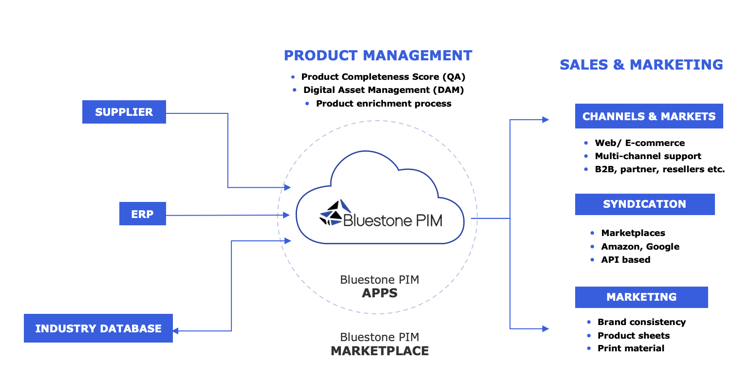
In the age of multichannel, maintaining accurate, synchronized data across all channels can be a headache for retailers. Without a go-to system of record, product information is doomed to become outdated, duplicated, or contradictory.
Introducing a single source of truth (SSoT) brings much-needed order to the data chaos.
Real-time data analysis can lead to overall revenue increases, and the path to such a bold impact on the bottom line starts with the consolidation of the data. And that's where a single source of truth comes in to help organizations gain full control over their data assets.
If you want to navigate omnichannel retail or operate as a data-driven business, establishing SSoT is critical.
In this article, you will learn all the essentials about a single source of truth, including benefits, and necessary steps to create a home for your product data. We also show you how modern Product Information Management (PIM) software can take most of these tasks off your shoulders.
What is a single source of truth (SSoT)?
Single source of truth (SSoT) is the data management philosophy of aggregating a company's data into a centralized and consistent repository. It should be a single, authoritative source that holds the most up-to-date and accurate information.
To understand the concept of the single source of truth and its significance, let's imagine a retail business landscape without a reliable data repository. It can cause many challenges, ranging from data inconsistencies to critical errors in decision-making.
Data silos, where information is trapped in specific departments or systems, can significantly disrupt collaboration between departments. Without a centralized repository, different teams can work with conflicting data sets, which can lead to confusion.
In short: data chaos everywhere.
A single source of truth eliminates duplicate or conflicting data across siloed systems and ensures that all teams have access to the same, verified information. It also reduces errors caused by working with outdated data feeds.
Businesses relying on a robust single source of truth find themselves empowered to make informed decisions and move forward with strategic initiatives with confidence.

Why is a single source of truth so important?
SSoT enables retail executives to instantly analyze trends and streamline operations by eliminating data silos.
This centralized approach ensures that everyone in the organization has efficient access to critical information, saving time and reducing errors.
Beyond operational efficiency, SSoT transforms the customer experience by providing a holistic view of customer data. Thanks to SSoT, retailers can offer personalized marketing, recommendations, and high-quality service, increasing customer satisfaction.
7 key benefits of an SSoT for product data
Establishing a centralized data repository and implementing the SSoT philosophy can bring many benefits to retail companies and their employees.
Here are the 7 benefits:
Better customer experience
A single source of truth ensures that customer information, purchase history, and customer preferences are maintained consistently across all channels. Based on this, retailers can tailor targeted, personalized messages and offers.
💡 Example: An electronics store set up an SSoT to bring all customer data together. This helped them study buying habits and make personalized email campaigns. For instance, they saw that people buying TVs often got soundbars too. With a special offer, they boosted soundbar sales by 25%, making the shopping experience better with smart cross-selling.
Enhanced supply chain efficiency
Centralizing inventory data facilitates better demand forecasting, reduces inventory costs, and prevents problems such as stockouts or overstocking. Retailers can optimize order processing and fulfillment. This leads to faster and more reliable deliveries, reducing order errors, and improving customer satisfaction.
Data-driven decision-making
An SSoT can provide retailers with reliable, up-to-date data to make informed decisions. This includes pricing strategies, product assortment, and operational improvements that lead to better overall business performance.
Reduced operational costs
An SSoT helps reduce the operational costs associated with manual data correction by eliminating data inconsistencies and errors. This efficiency gain allows retailers to use their resources more effectively.
Increased productivity
An SSoT fosters collaboration among different departments within a retail organization. When everyone is working with the same data set, communication barriers are minimized, resulting in better teamwork and increasing the overall efficiency of the company.
💡 Example: After implementing an SSoT for product data, an apparel retailer's marketing and merchandising teams could collaborate live on seasonal catalog planning. This streamlined the process, completing the catalog 50% faster.
Readiness for omnichannel
Up-to-date and high-quality product information in one place makes it easier for retailers to offer seamless customer experiences across multiple channels. SSoT also helps them keep pace with changing trends and customer expectations.
Adaptability to market changes
In the fast-paced retail industry, adapting quickly to market changes is crucial. By utilizing an SSoT, retailers can respond quickly to shifting consumer behavior, market trends, and competitive landscapes.
5 challenges you should note before establishing an SSoT
As you can see, setting up an SSoT has many benefits for retailers, but also brings some challenges.
To overcome these challenges, retailers need a comprehensive strategy, leadership commitment, and collaboration between departments.
Data quality and consistency
Ensuring that the data in SSoT is of high quality, accurate, consistent, and up-to-date can be a challenge.
Inaccurate or inconsistent data can lead to misinformation and poor decisions.
Data integration
Retailers often have disparate and distributed data sources, including legacy systems, third-party applications and different departments.
Integrating these different sources can be complex and time-consuming.
Data governance and security
Adhering to data governance and ensuring the security of sensitive information is crucial.
Defining roles, responsibilities and access controls is necessary to protect the integrity and confidentiality of data. Retailers must comply with various data protection and privacy regulations. To comply with these regulations, an SSoT must be carefully planned and monitored.
Technology compatibility
Retailers may have a mix of legacy systems and newer technologies. Therefore, they need to be sure that the SSoT is compatible with existing technologies and can evolve with new technologies.
As data volumes grow, the SSoT needs to be scalable to handle the increased load. Retailers need to plan for scalability to handle business growth and avoid performance issues.
Data ownership and accountability
Another challenge is to clearly define who owns the data and who is responsible for data quality. Without clear ownership, there can be a lack of responsibility for maintaining and updating the SSoT.
Follow these 10 steps when implementing an SSoT
Here are some important steps to create a single source of truth in a retail business:
-
Step 1 — Setting the scope: Define what information needs to be part of the single source of truth. This includes things like product catalogs, pricing, inventory, media (images, videos), etc.
-
Step 2 — Aggregating data: Identify the existing sources for this data in different systems such as ERP, e-commerce platform, POS, CRM, etc. and bring them together in a centralized database.
-
Step 3 — Data scouring: Standardize and cleanse the data to remove duplicates, incorrect values, and inconsistencies between sources. Standard data formats, codes, etc. should be defined.
-
Step 4 — Data governance framework: Define who is responsible for the data, how it is entered and updated. Clear roles and responsibilities need to be defined.
-
Step 5 — Real-time Integration of systems: Restrict the updating of data from multiple locations. Only authorized roles/systems should be allowed to directly update the single source of truth.
-
Step 6 — Controlled data updating: Implement ongoing data quality processes such as data validation, audits, etc. to ensure accuracy and consistency over time.
-
Step 7 — Regular corrections: Adopt ongoing data quality processes like data validation, audits etc. to ensure correctness and consistency over time.
-
Step 8 — Set accessibility: Make the single source accessible to all internal users and systems via appropriate APIs or reporting tools.
-
Step 9 — Utilizing Master Data Management: Consider additional technologies such as master data management to further standardize entities such as products, customers, etc. across the organization.
-
Step 10 — Training for internal teams: Train your employees to use the single source of truth for their tasks to avoid duplication of work.
This process may seem like a daunting task. But luckily, the technology is there to help you.
There are specialized data management tools that help retailers capture and manage product information.
What systems can be used as an SSoT?
The single source of truth is more about an approach to consolidating your data than a specific strategy or tool.
The most commonly used solutions for this purpose are Master Data Management and Product Information Management.
Product Information Management (PIM)
A Product Information Management (PIM) system is the linchpin for establishing and maintaining a single source of truth specifically for product information.
By offering a centralized repository for core product records, attributes, images, and specifications, a PIM guarantees quality and consistency through robust data modeling, attribute selection, and input validation during updates.
Effectively implemented, a PIM becomes the single source of product information within an organization.
It consolidates data from different systems and enriches it into complete, up-to-date content for distribution across sales channels, eCommerce websites and retailers.
Key features that make a PIM a single source of truth include a centralized product database, workflows for data ingestion and validation, data quality checks, enrichment from other systems, user access control and an audit trail for changes and version control.
With solid data governance, a PIM becomes the central hub for authoritative, standardized product information across all channels and internal systems.
Master Data Management (MDM)
Master Data Management (MDM) is suitable for companies that manage different data domains such as customer, financial, product or employee data. The aim is to create an accurate, trustworthy view of the data for enterprise-wide decision-making.
Although both PIM and MDM aim to provide a centralized, trusted data source, the main difference lies in their focus.
MDM primarily supports internal business processes and promotes collaboration between departments, while the PIM system is geared towards external processes and ensures omnichannel consistency across different platforms.
Read on to learn more: PIM vs MDM: Functions, Benefits, and Differences
Other data management tools
-
Enterprise Resource Planning (ERP) systems — Integrated software that manages key retail operations such as inventory, purchasing, accounting, sales, etc. based on a common database.
-
Product Data Syndication (PDS) tools — Enables automatic syndication and publishing of product information from the PIM/MDM to all marketplace and sales channels.
-
Digital Asset Management (DAM) systems — Central repositories for marketing assets such as digital photos, videos, documents, etc.
-
BI/Analytics platforms — Help analyze insights from SSoT data to optimize merchandising, pricing and other strategies.
-
API integration — Connects disparate systems to facilitate the mutual exchange of SSoT data in real time.
-
Cloud infrastructure — Hosting SSoT databases and related tools in the cloud improves data accessibility, scalability and synchronization.
All of these solutions can be integrated with each other and the PIM software can be a central hub for product data that is synchronized with DAM, ERP and other applications via APIs.
Learn more about the role of PIM below, as this tool is critical for global retail brands, their communication with suppliers and the distribution of product content in a multi- and omnichannel environment.
How Bluestone PIM helps retailers centralize product information
Bluestone PIM provides a seamless solution for creating a single source of truth for all your product information.
By effortlessly importing data from various sources such as files, databases and API connections, you can bring all product information together in one centralized location. The platform allows you to efficiently manage large amounts of data and automate repetitive tasks.
You can save valuable time by using customizable templates. You have the flexibility to structure information as you wish.
Our composable PIM presents a number of possibilities for retailers their work with product data hassle-free and highly collaborative.

Case study: Starboard
Starboard, a prominent water sports brand, had no centralized solution to manage its entire ecosystem, and setting up a single source of truth for product information management was proving to be extremely cumbersome.
Bluestone PIM has significantly improved Starboard’s data management and saved the teams a lot of time. In addition, Starboard utilizes Bluestone PIM's headless capabilities to efficiently manage product data across multiple channels from a single platform.
Download the free case study below to learn more.
If you want to cover the basics of a PIM solution and its capabilities, check out our Complete Guide to PIM.
Final thoughts
Implementing a single source of truth through tools like a Product Information Management system can revolutionize data management in retail businesses, streamline operations, and support you in effectively managing your omnichannel strategy.
Embrace the philosophy of a single source of truth to unlock the full potential of your business data and stay ahead in today's competitive market.
Want to learn more about Bluestone PIM and how it can help you take your product information management to the next level? Schedule a free consultation with our PIM advisors or reserve a demo to see Bluestone PIM in action.
Tags
Data ManagementYou might also like
![[Webinar] Benefits of API-ready SaaS for PIM](https://www.bluestonepim.com/hubfs/Bluestone_Feb2022/images/webinar_blog_thumb-1.png)
[Webinar] Benefits of API-ready SaaS for PIM

5 Reasons Why Small Businesses Should Move to Cloud



